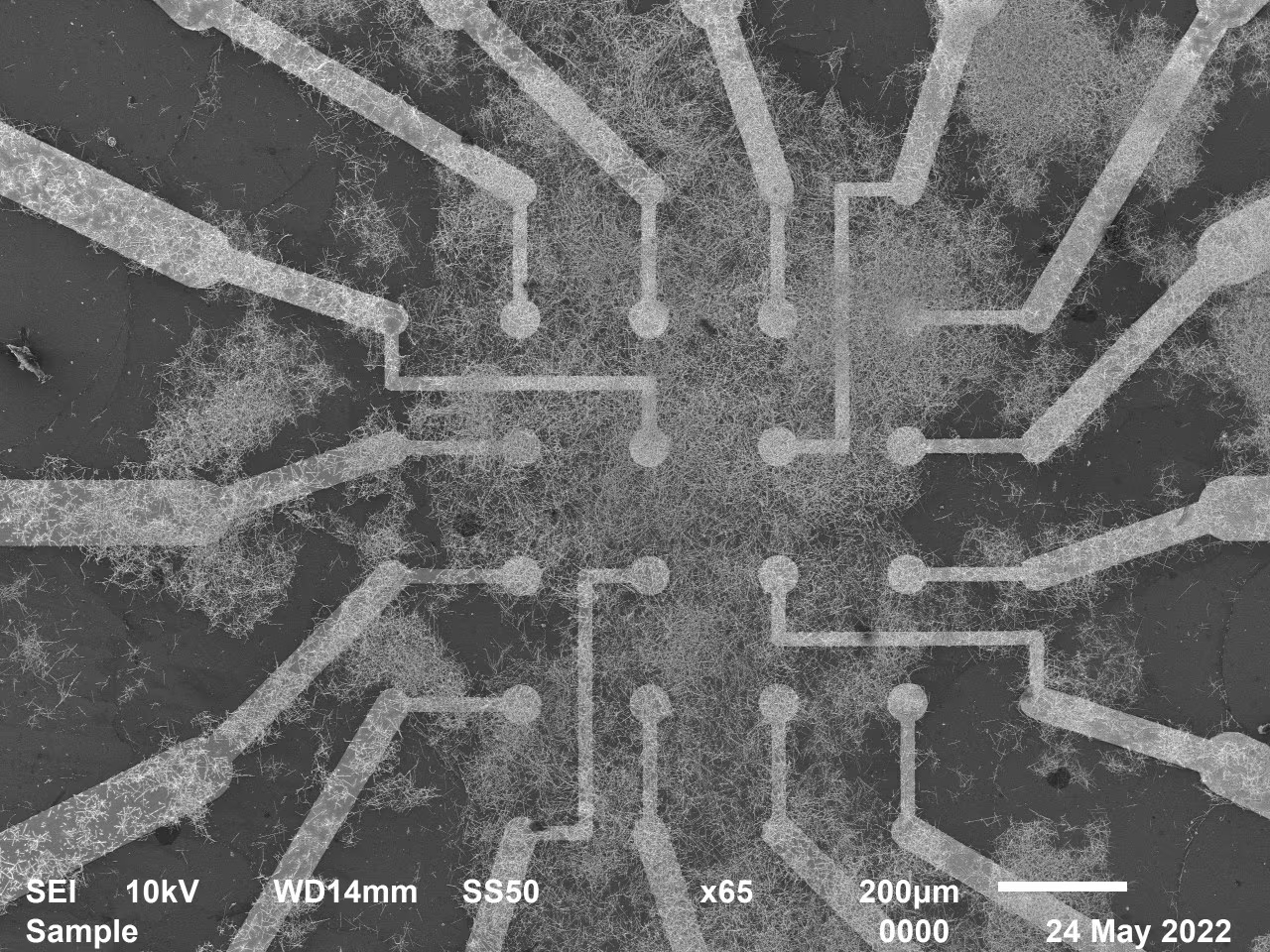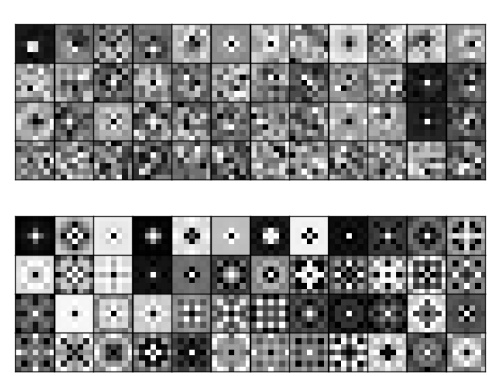
Electrodes interact with the nanowire neural network at the heart of the chip.
Critical step passed for developing ‘agile’ and low-energy machine intelligence
Like a collection of ‘Pick Up Sticks’, the self-arranged network of nanowires mimics the synapse function of the brain. In this experiment, a network was trained to access dynamic online data that it learnt and memorised.
For the first time, a physical neural network has successfully been shown to learn and remember ‘on the fly’, in a way inspired by and similar to how the brain’s neurons work.
The result opens a pathway for developing efficient and low-energy machine intelligence for more complex, real-world learning and memory tasks.
Published today in Nature Communications, the research is a collaboration between scientists at the University of Sydney and University of California at Los Angeles.
Lead author Ruomin Zhu, a PhD student from the University of Sydney Nano Institute and School of Physics, said: “The findings demonstrate how brain-inspired learning and memory functions using nanowire networks can be harnessed to process dynamic, streaming data.”
Nanowire networks are made up of tiny wires that are just billionths of a metre in diameter. The wires arrange themselves into patterns reminiscent of the children’s game ‘Pick Up Sticks’, mimicking neural networks, like those in our brains. These networks can be used to perform specific information processing tasks.
Memory and learning tasks are achieved using simple algorithms that respond to changes in electronic resistance at junctions where the nanowires overlap. Known as ‘resistive memory switching’, this function is created when electrical inputs encounter changes in conductivity, similar to what happens with synapses in our brain.
In this study, researchers used the network to recognise and remember sequences of electrical pulses corresponding to images, inspired by the way the human brain processes information.
Supervising researcher Professor Zdenka Kuncic said the memory task was similar to remembering a phone number. The network was also used to perform a benchmark image recognition task, accessing images in the MNIST database of handwritten digits, a collection of 70,000 small greyscale images used in machine learning.
“Our previous research established the ability of nanowire networks to remember simple tasks. This work has extended these findings by showing tasks can be performed using dynamic data accessed online,” she said.
“This is a significant step forward as achieving an online learning capability is challenging when dealing with large amounts of data that can be continuously changing. A standard approach would be to store data in memory and then train a machine learning model using that stored information. But this would chew up too much energy for widespread application.
“Our novel approach allows the nanowire neural network to learn and remember ‘on the fly’, sample by sample, extracting data online, thus avoiding heavy memory and energy usage.”
Mr Zhu said there were other advantages when processing information online.
“If the data is being streamed continuously, such as it would be from a sensor for instance, machine learning that relied on artificial neural networks would need to have the ability to adapt in real-time, which they are currently not optimised for,” he said.
In this study, the nanowire neural network displayed a benchmark machine learning capability, scoring 93.4 percent in correctly identifying test images. The memory task involved recalling sequences of up to eight digits. For both tasks, data was streamed into the network to demonstrate its capacity for online learning and to show how memory enhances that learning.
Original Article: Nanowire ‘brain’ network learns and remembers ‘on the fly’
More from: University of Sydney | University of California Los Angeles
The Latest Updates from Bing News
Go deeper with Bing News on:
Nanowire neural network
- AI Efficiency Breakthrough: How Sound Waves Are Revolutionizing Optical Neural Networks
Researchers have developed a way to use sound waves in optical neural networks, enhancing their ability to process data with high speed and energy efficiency. Optical neural networks may provide the ...
- Neural networks can mediate between download size and quality, according to researcher
Application data requirements vs. available network bandwidth have been the ongoing Battle of the Information Age, but now it appears that a truce is within reach, based on new research from NJIT ...
- Amazing! The classical optical neural network exhibits “quantum speedup”
To address the issue, great efforts have been made in two research directions, which are optical neural networks and quantum neural networks. Optical neural networks utilize advanced optical ...
- Classical optical neural network exhibits 'quantum speedup'
To address the issue, great efforts have been made in two research directions: optical neural networks and quantum neural networks. Optical neural networks utilize advanced optical manipulation ...
- Rhianna-lily Smith
During her MSc, she developed a passion for science communication and later joined Technology Networks as a Junior Science Editor, where she works with the news team to cover the latest breaking news ...
Go deeper with Bing News on:
Nanowire networks
- The Learning Network
By The Learning Network What have you bought, watched, listened to, read, made, eaten or tried out because someone on TikTok, Instagram or X suggested you should? By Katherine Schulten What do ...
- The Learning Network
How good is your graph literacy? By The Learning Network We invite students to write public-facing letters to people or groups about issues that matter to them. Contest dates: March 13 to May 1.
- DISH Network Reviews
It's ridiculous that to get Dish tv and internet. It cannot be done on the same day. And then for either one. You're told between 8 a.m. and 5 p.m. They should be able to give a 2 hr. Window at most.
- The Real News Network
To protect your anonymity when using SecureDrop, it is essential that you do not use a network or device that can easily be traced back to your real identity. Instead, use public wifi networks and ...
- Mobile Networks in the UK 2024
What is a mobile network? A mobile network is the infrastructure that enables your phone and other mobile devices, such as tablets, to connect with each other and to the internet. The network is ...










